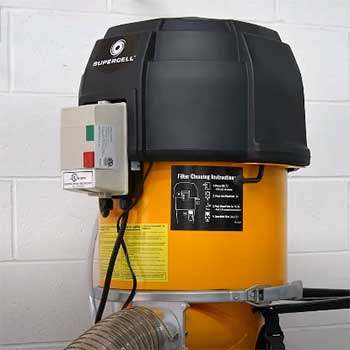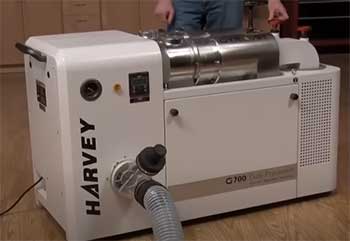Oneida is an air dusting system that requires a vacuum to extract fine particles over time. The Oneida process can remove particles up to 2 microns in diameter from the air.
However, this process can be less effective with larger particles and heavy metals such as lead. The Harvey G700is designed for large outdoor operations where higher concentrations of particulates are present, typically due to industrial processes.
This post will discuss other differences between the two air dust processors.
A Brief Comparison Table
| Specification | Oneida Supercell | Harvey G700 Gyro |
| How it works | Highly innovative demagnetization system | Highly innovative tandem cryogenic dust extraction system |
| Start-up time | The machine starts to work once you press the start button. | It takes a few seconds for the device to reach its high power capacity. |
| Suction power | Superior suction power | Solid and constant suction power. |
| Noise control | Very loud | It does not produce much noise |
| Dust management | Has exceptional HEPA filtration and large trash bags. | Has large gallons for dust collection. |
| Price | Around $2845 | Around $2170 |
Main Differences Between Oneida Supercell And Harvey G700 Gyro Air Dust Processor
- How Does It Work?

The Oneida Supercell is a highly innovative demagnetization system with an array of optimized magnetic field lines that create a supercell-type field with almost all particles being captured inside the capture volume at any given time.
This process requires a high magnetic flux density (B) and extremely low reluctance (R) to achieve this goal.
The Oneida Supercell is designed to complete one of the market’s most potent and efficient supercells.
The Harvey G700 is an innovative tandem cryogenic dust extraction system that processes air particles for dust settling and re-suspension applications. The G700 is the successor to the Harvey G600 and has been redesigned from the ground up with a clean-sheet approach.
The G700 offers significant advancements to its predecessor while maintaining all the features that make it a superior machine.
The processing area of the Harvey G700 has been increased by 50% over the G600, and airflow is double that of its predecessor. While maintaining a footprint less than half that of similar-sized systems on the market, the G700 uses advanced technology to achieve almost dust-free air.
- Start-Up Time
Aside from it being very effective, you will have to wait a bit longer for Harvey G700 to reach its full power and start functioning. Oneida supercell dust collector takes little time to start. Once you press the remote control, the machine begins collecting dust around the shop.
- Suction Power
Oneida supercell air dust processor has a superior suction power ten times higher than a standard air dust processor. It is the only dust collector in the market with high static pressure and airflow level capable of capturing dust particles between 1″ to 5″.
Harvey G700 also has superior suction power with the presence of NodFab ductwork, ensuring you do not lose any suction even from the furthest port. The dust collector has variable suction power control, and the suction power is constant and robust.
- Noise Control
Oneida supercell dust collector has a loud, powerful shop-vac-like sound. The sound insulation foam under the black hood somewhat reduces the highest frequencies, but only to a certain extent.
The sound of air rushing through smaller openings is another disturbance. Without isolating it in a different room or closet, you must use hearing protection with this product.
The Harvey G700 dust collector is quite impressive regarding noise control. The machine is among the most-quiet dust collector and only produces a low hum that is not audible. This means the device will not disturb you when it is doing its work,
- Dust Management

The 32-gallon dust bin available on Harvey G700 is large enough to contain dust gathered from a single job and lightweight enough not to strain your back when emptying the container.
The lower bin size should be easy to open regularly if you’re processing hundreds of board feet daily.
Rubber bands with the package are used to secure the strong bags.
These bands are thick enough to endure use over time and hold the bag’s lip in place very well. The dust container can store dust for up to six months if you are working on modest projects.
A dust collector made by Oneida with unique HEPA filtration. The Supercell’s integrated bag retainer holds disposable plastic liner bags open inside the drum using negative pressure, making waste disposal quick and easy.
There is no need to carry and dump out large, heavy containers when the drum is complete because the lid can be easily removed, the bag can be tied off, and the drum can be lifted out.
This is made possible by the built-in dust level sensor. Using your vacuum no longer requires guesswork, thanks to Oneida Air Systems’ innovative Dust Sentry!
This movable optical sensor determines when the drum has reached a preset amount of filling and flashes a bright strobe light to warn you that it’s time to empty it.
- Price
Oneida supercell dust collector retails at $2845 while Harvey G700 retails at $2170. This means that Oneida is more expensive than Harvey G700, but their prices are subject to change depending on where you purchase the dust collectors.
Frequently Asked Questions (FAQ)
According to the manufacturer, Oneida has a loudness of 80decibels. However, after using the dust collector, you will realize it is way louder than claimed. Fortunately, there are ways you can control the noise produced by the machine.
Oneida dust collectors are manufactured in Syracuse, New York, U.S.A.
The Oneida brand is owned and operated by Oneida Limited Partnership, which was created in 1993. It’s a privately-held company that’s based in Sherrill, New York. The company’s president, chairman, and CEO is William J. Monahan III.
Yes. Oneida dust collectors are made in the USA.
Conclusion
You might not have heard of Oneida Supercell or Harvey G700 dust collectors, but they are two competing brands of dust collectors that offer different sets of benefits.
On the one hand, Oneida provides a cleaner and longer-lasting filter; on the other hand, Harvey offers a giant capacity bag with faster sorting.
Oneida Supercell and Harvey G700 comparison has all the other differences between the dust collectors. The differences will help you decide which dusty collector is ideal for your projects.
